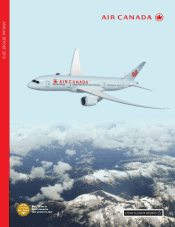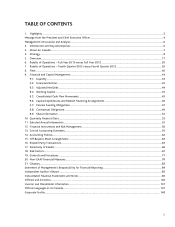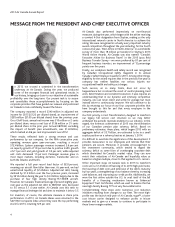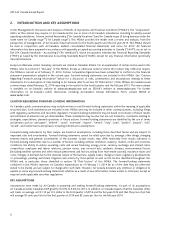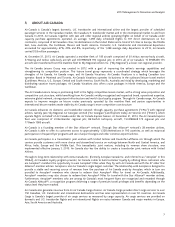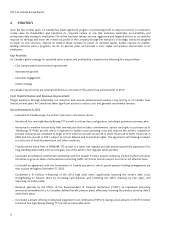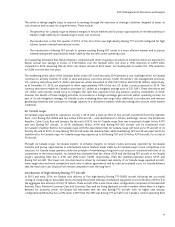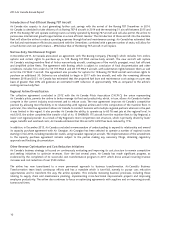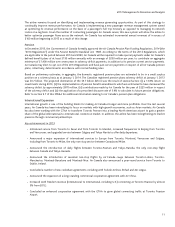Air Canada 2013 Annual Report Download - page 4
Download and view the complete annual report
Please find page 4 of the 2013 Air Canada annual report below. You can navigate through the pages in the report by either clicking on the pages listed below, or by using the keyword search tool below to find specific information within the annual report.
2013 Air Canada Annual Report
4
MESSAGE FROM THE PRESIDENT AND CHIEF EXECUTIVE OFFICER
n 2013, we crossed a watershed in the transformation
underway at Air Canada. During the year, we produced
some of the strongest financial and operational results in
our history, bringing us closer to our objective of sustainable
profitability over the long term. Our present task is to secure
and consolidate these accomplishments by focusing on the
corporate priorities that have guided our renewal and positioned
Air Canada to look confidently toward the future.
The company reported a record $340 million in adjusted net
income for 2013 ($1.20 per diluted share), an improvement of
$285 million ($1.00 per diluted share) from the previous year.
On a GAAP basis, annual net income was $10 million or 2 cents
per diluted share, versus a net loss of $136 million or 51 cents
per diluted share in the prior year. Annual EBITDAR, excluding
the impact of benefit plan amendments, was $1.43 billion,
which marked an 8.6 per cent improvement over 2012.
These results reflected both a strong revenue and cost
performance by our company. For the fifth consecutive year,
operating revenue grew year-over-year, reaching a record
$12.4 billion. System passenger revenue increased 2.6 per cent
on capacity growth of 1.9 per cent due to positive traffic growth
of 2.1 per cent and yield growth of 0.5 per cent, while adjusted
unit costs decreased 1.5 per cent. Passenger revenue grew in
most major markets, including domestic, transborder and on
both the Atlantic and Pacific.
We reported a full year record load factor of 82.8 per cent,
meaning our aircraft flew fuller than ever. At year-end, we had
unrestricted liquidity of $2.4 billion. Adjusted net debt, having
declined by $1.3 billion over the four previous years, increased
by $214 million during the year to $4.3 billion, largely due to the
purchase of four high density Boeing 777-300ER aircraft.
However, Air Canada’s financial leverage improved slightly year-
over-year as the adjusted net debt to EBITDAR ratio decreased
to 3.0 versus 3.1 a year earlier. Air Canada uses this ratio to
manage financial leverage risk and aims to maintain it below 3.5.
For investors, of course, the ultimate measure is share price
performance. In 2013, Air Canada shares were returned to the
S&P/TSX Composite Index where they were the top performing
stock for 2013, returning 323 per cent.
Air Canada also performed impressively on non-financial
measures during the year, which began with the airline receiving
a coveted 4-Star designation from Skytrax, making us the only
international network carrier in North America to achieve this
rating. We were recognized in virtually every important industry
award competition throughout the year including, for the fourth
consecutive year, “Best Airline in North America” in a worldwide
survey of more than 18 million air travelers for Skytrax’s 2013
World Airline Awards. Air Canada was also named “Canada’s
Favourite Airline for Business Travel” in the 2013 Ipsos Reid
Business Traveler Survey – we were preferred by 81 per cent of
frequent business travelers, an improvement of 12 percentage
points over five years.
Finally, our workplace health and safety record was recognized
by Canadian Occupational Safety magazine in its annual
Canada’s Safest Employer Awards for 2013. Among other things,
eligibility for the award requires that in the previous five years a
company has neither fatalities nor serious injuries nor
occupational health and safety act charges.
Such success, on so many fronts, does not occur by
happenstance but is instead the result of careful planning, hard
work, determination and consistent execution. It also requires an
understanding that in our dynamic and intensely competitive
industry, one can never relent and settle for average but must
instead strive to continuously improve. We will continue to do
this by retaining our focus on our four corporate priorities that
have brought us this far and that every employee in the
company understands.
Our first priority is Cost Transformation, designed to transform
our legacy full service cost structure so we may better
withstand the periodic reversals endemic to our industry. In this
regard, the foremost achievement of 2013 was the elimination
of our Canadian pension plan solvency deficit. Based on
preliminary estimates, these plans, which began 2013 with an
aggregate deficit of $3.7 billion, are estimated to be in a small
surplus position on a solvency basis as at January 1, 2014.
It is difficult to overstate the significance of this development. It
provides reassurance to our employees and retirees that their
pensions are secure. Moreover, it provides encouragement to
the investment community, which tended to regard the
solvency deficit as some form of overhanging corporate debt
which diminished Air Canada’s market value. They can now
revisit their valuations of Air Canada and hopefully value us
based on a higher multiple, closer to that applied to U.S. carriers.
Other important steps Air Canada took in 2013 to transform
costs were a $1.4 billion refinancing of its 2010 high yield notes,
the lowering of debt costs and extension of the debt’s maturity
by four years, a strengthening of our balance sheet by increasing
cash balances, and improving our credit profile. Additionally, we
were the first airline outside the U.S. to avail itself of the full
benefits of a financing mechanism known as Enhanced
Equipment Trust Certificates, which we used to finance the five
new high density Boeing 777s on very favourable terms.
Complementing these steps were numerous cost reduction
initiatives resulting from changes to our fleet. The most high-
profile was the launch mid-year of Air Canada rouge™, a lower
cost leisure carrier designed to enhance profits in leisure
markets and to give us a means to continue to participate in
these lower-margin markets.
I

